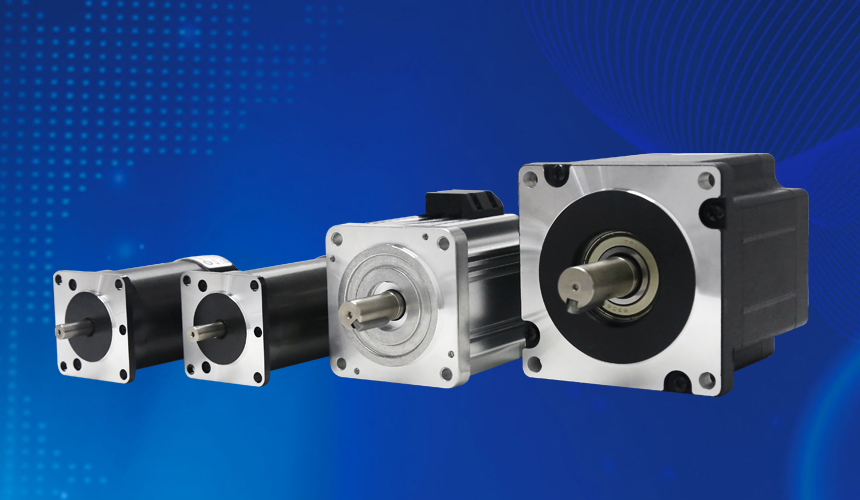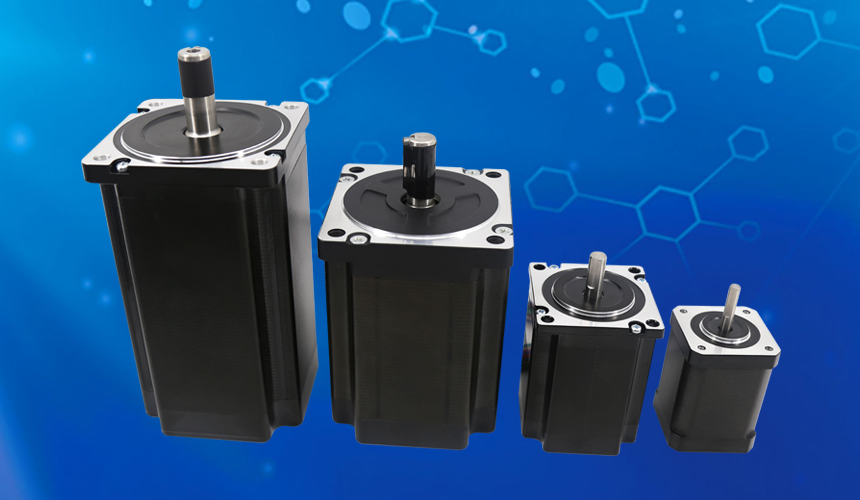Brushless Direct Current Motor (BLDC), also known as electronically commutated motor (ECM or EC motor) or synchronous DC motor, is a synchronous motor that uses direct current (DC) power. The brushless DC motor is essentially a permanent magnet synchronous motor that uses DC power input and uses an inverter to convert it into a three-phase AC power supply with position feedback.
There are various types of motors, and brushless DC motors are the most ideal speed-controlled motors today. It combines the advantages of DC motors and AC motors. It not only has the good adjustment performance of DC motors, but also has the advantages of simple structure, no commutation sparks, reliable operation and easy maintenance of AC motors. Therefore, it is very popular in the market and is widely used in automobiles, home appliances, industrial equipment and other fields.
A stepper motor is an open-loop control motor that converts electrical pulse signals into angular displacement or linear displacement. It is also called a pulse motor. Under non-overload conditions, the motor’s speed and stopping position only depend on the frequency and number of pulses of the pulse signal and are not affected by load changes. When the stepper driver receives a pulse signal, it can drive the stepper motor to rotate in a set direction by a fixed angle, called the “step angle”. The rotation of the stepper motor operates step by step at a fixed angle. The angular displacement can be controlled by controlling the number of pulses to achieve accurate positioning. At the same time, the speed and acceleration of the motor rotation can be controlled by controlling the pulse frequency. Thereby achieving the purpose of speed regulation. Stepper motors are mostly used in peripheral equipment of digital computers, as well as devices such as printers, plotters, and disks.
The main differences between brushless DC motors and stepper motors are as follows:
1. The brushless DC motor has a higher speed than the stepper motor.
2. The driving principle of the brushless DC motor is different from that of the synchronous motor. The brushless DC motor relies on the alternating power supply provided by the positioning of the Hall element to control the rotation. The stepper motor is directly driven by a single pulse voltage and does not require Hall element positioning. The angle of rotation can be accurately positioned by controlling the number of pulses applied to the motor.
3. The driving principles are different, so brushless DC motors are generally used in places where control accuracy is not high. Stepper motors are used where control accuracy is required.
Brushless DC motors can be divided into three main uses:
Continuous load applications: Mainly areas that require a certain speed but do not have high requirements for speed accuracy, such as fans, water pumps, hair dryers, etc. These applications are low-cost and mostly open-loop control.
Variable load applications: Mainly applications where the speed needs to change within a certain range, which has higher requirements for motor speed characteristics and dynamic response time characteristics. For example, dryers and compressors in household appliances are good examples. Oil pump control, electric controllers, engine controls, etc. in the automotive industry have relatively higher system costs for such applications.
Positioning applications: Most industrial control and automatic control applications belong to this category. Energy transmission is often completed in such applications, so there are special requirements for the dynamic response of the speed and torque, and the requirements for the controller are also higher. . Optoelectronics and some synchronization equipment may be used when measuring speed. Process control, machine control, and transportation control are many examples of this type of application.
The main features of stepper motors include:
1. Generally, the accuracy of stepper motors is 3-5% of the step angle and does not accumulate.
2. The maximum temperature allowed on the surface of the stepper motor.
If the temperature of the stepper motor is too high, it will first demagnetize the magnetic material of the motor, resulting in a decrease in torque and even loss of step. Therefore, the maximum temperature allowed on the surface of the motor should depend on the demagnetization point of the magnetic material of different motors; generally speaking, the demagnetization of magnetic materials The points are all above 130 degrees Celsius, and some are even as high as above 200 degrees Celsius, so the surface temperature of the stepper motor is completely normal at 80-90 degrees Celsius.
3. The torque of the stepper motor will decrease as the speed increases.
When the stepper motor rotates, the inductance of each phase winding of the motor will form a reverse electromotive force; the higher the frequency, the greater the reverse electromotive force. Under its action, the phase current of the motor decreases as the frequency (or speed) increases, resulting in a decrease in torque.
Since its establishment, Shenzhen Zhongling Technology Co., Ltd. has been focusing on the research of brushless DC motors and stepper motors, and has obtained a number of patents and has rich experience. The brushless DC motors and stepper motors produced by the company are also sold at home and abroad, becoming the best choice for many robot companies and many automation equipment manufacturing companies.
Post time: Sep-14-2023


